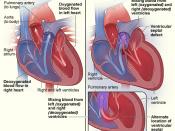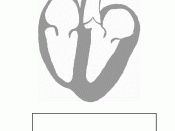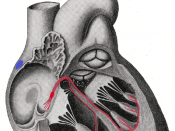Cardiovascular System
Structure
lies within thorax b/w lungs in the mediastinal space
beating is palpable @ 5th intercostals space, approx 2 in. left of midline
this pulsation (arising at the apex of the heart) is termed point of maximal impulse.
Endocardium = thin, inner lining/layer
Myocardium = layer of muscle
Epicardium = fibrous, outer layer
Heart is surrounded by the pericardium
o Inner (visceral) layer is in contact with the epicardium
o Outer (parietal) layer is connected with the mediastinum
Pericardial fluid lubricates the space b/w the pericardial layers and prevents friction.
Heart is divided vertically by the septum
Atrial myocardium is thinner than that of the ventricle
Left ventricular wall is 3 times thicker than the right b/c it has the force to pump blood into the system.
Blood Flow Through Heart
1) Inferior and superior vena cavae
2) Right atrium
3) Tricuspid valve
4) Right ventricle
5) Pulmonic valve
6) Pulmonic artery to lungs
7) (from lungs) to left atrium
8) mitral valve
9) left ventricle
valves serve to keep blood flowing in forward direction
mitral and tricuspid valves are attached to chordae tendineae that prevents the eversion into the atria during ventriclar contraction
pulmonic and aortic valves (semi-lunar valves) prevent blood from regurgitating into ventricles at end of each ventricular contraction.
Blood Supply to the Myocardium
own blood supply = coronary circulation
blood flow into coronary arteries occur primarily during diastole.
In 90% of people, the AV node & bundle of His receive blood from the right coronary artery.
Most of the blood from the coronary system drains into coronary sinus, which empties into the right atrium near the entrance of the inferior vena cavae.
Conduction system
Specialized nerve tissue responsible for creating and transporting the electrical impulse or action potential.
Impulse initiates depolarization & cardiac contraction.



Unfortunate formatt
I am guessing the format has altered when this paper was submitted because iI am unable to make scense of it.
0 out of 0 people found this comment useful.